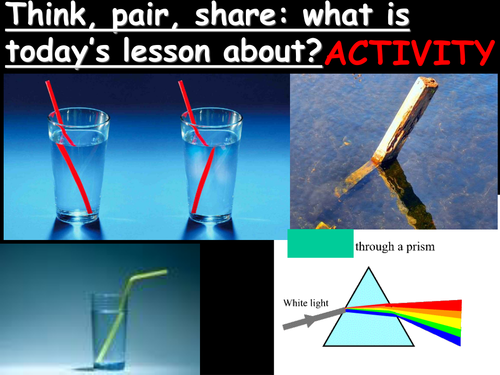


This lesson is 3 in a series of 5 that expertly and fully delivers all the points within the NEW KS3 specification SoW on the “light” topic.
I find that this powerpoint and its interesting activities keep lower level students engaged during the lesson while allowing differentiation for higher achievers. I’m sure you’ll find it useful.
For more lessons designed to meet the new KS3 and KS4 specifications please type Barclayfox into the tes resources search engine to see all my lessons.
STARTER
Pupils will start the lessons by thinking/working in pairs to solve a picture puzzle to find out what today’s lesson is about. After revealing the title and lesson outcomes students self assess against their current understanding of this topic. Next there is a scientific literacy Q&A activity to ensure all students learn the key words required to understand this lesson.
MAIN
The slides then move on to lead the students into understanding refraction. TTN is introduced as a means of working out whether refraction with bend light towards or away from the normal. Students then undertake an activity and apply TTN to predict the way the light bends at various boundaries between various mediums, they then self-assess using the answers provided.
MAIN
Next, the lesson focuses on two types of lenses, concave and convex. Diagrams are clear and help get the key points across succinctly and accurately. Students are shown incident rays into a concave lens and then try to predict and draw the ray diagram for the refracted rays.
MAIN
Students do a class practical with ray boxes and glass blocks to investigate refraction. Students share their results and observations and then undertake a quiz to bring out the key points from the experiment.
MAIN
Students do a gap fill activity – this can be differentiated by providing or not providing the missing words, they then and self-assess or peer assess using the answers provided.
MAIN
Refractive index is introduced and students undertake some calculations based around refractive index. This is peer-assessed using the model answers provided.
PLENARY
Each student self-assesses versus each of the objectives and marks their progress on their progress bars.
EXTENSION ACTIVITIES
A variety of activities are provided just in case any of your groups requires them either this year or in future years.
All resources are included in this great lesson, there is nothing for you to do but order the equipment for the class practical (simply hand your technician the printed off kit list.doc).
Thank you for looking, your feedback is much appreciated! :)
Lesson 3 in a series of 5.
Happy teaching,
Barclayfox.
I find that this powerpoint and its interesting activities keep lower level students engaged during the lesson while allowing differentiation for higher achievers. I’m sure you’ll find it useful.
For more lessons designed to meet the new KS3 and KS4 specifications please type Barclayfox into the tes resources search engine to see all my lessons.
STARTER
Pupils will start the lessons by thinking/working in pairs to solve a picture puzzle to find out what today’s lesson is about. After revealing the title and lesson outcomes students self assess against their current understanding of this topic. Next there is a scientific literacy Q&A activity to ensure all students learn the key words required to understand this lesson.
MAIN
The slides then move on to lead the students into understanding refraction. TTN is introduced as a means of working out whether refraction with bend light towards or away from the normal. Students then undertake an activity and apply TTN to predict the way the light bends at various boundaries between various mediums, they then self-assess using the answers provided.
MAIN
Next, the lesson focuses on two types of lenses, concave and convex. Diagrams are clear and help get the key points across succinctly and accurately. Students are shown incident rays into a concave lens and then try to predict and draw the ray diagram for the refracted rays.
MAIN
Students do a class practical with ray boxes and glass blocks to investigate refraction. Students share their results and observations and then undertake a quiz to bring out the key points from the experiment.
MAIN
Students do a gap fill activity – this can be differentiated by providing or not providing the missing words, they then and self-assess or peer assess using the answers provided.
MAIN
Refractive index is introduced and students undertake some calculations based around refractive index. This is peer-assessed using the model answers provided.
PLENARY
Each student self-assesses versus each of the objectives and marks their progress on their progress bars.
EXTENSION ACTIVITIES
A variety of activities are provided just in case any of your groups requires them either this year or in future years.
All resources are included in this great lesson, there is nothing for you to do but order the equipment for the class practical (simply hand your technician the printed off kit list.doc).
Thank you for looking, your feedback is much appreciated! :)
Lesson 3 in a series of 5.
Happy teaching,
Barclayfox.
Get this resource as part of a bundle and save up to 22%
A bundle is a package of resources grouped together to teach a particular topic, or a series of lessons, in one place.
Something went wrong, please try again later.
This resource hasn't been reviewed yet
To ensure quality for our reviews, only customers who have purchased this resource can review it
Report this resourceto let us know if it violates our terms and conditions.
Our customer service team will review your report and will be in touch.
£3.99
